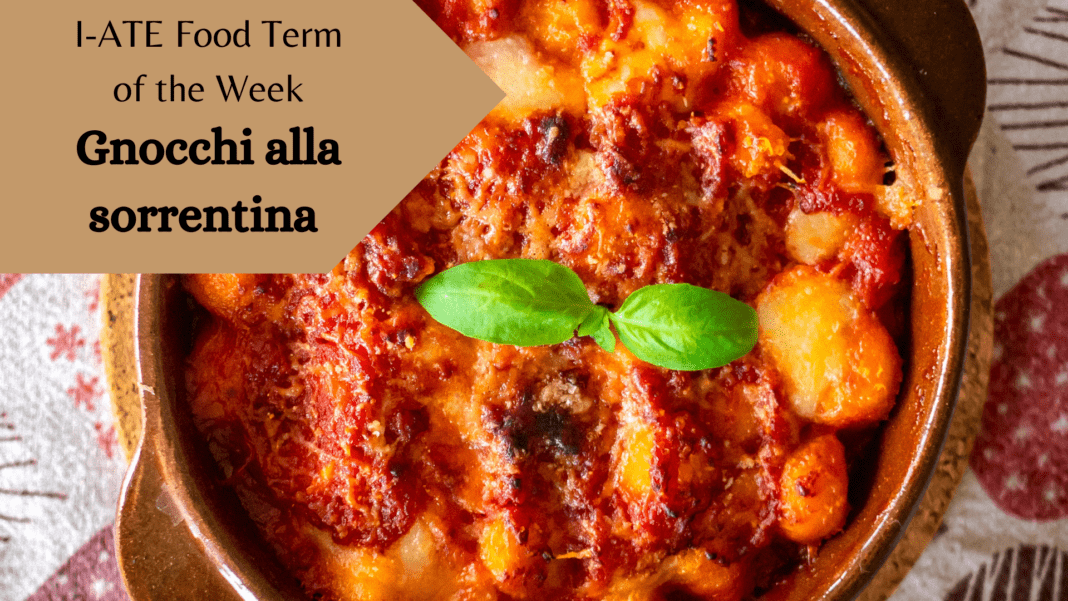Gnocchi is one of the most ancient and popular Italian food, and many Italian regions claim its origins. Roman legions spread this dish throughout the European regions they conquered, and it became a peasant food as it was cheap, easy to prepare and nourishing.
While it was generally associated with northern Italy (Trentino Alto Adige), the truth is that these dumplings are found all over the Italian Peninsula in many diverse forms, made with a variety of base ingredients: flour, corn meal, semolina, bread, chestnut flour, ricotta, polenta or vegetables (pumpkin or spinach). However, what is sure is that the best-known kind of gnocchi is the potato gnocchi, an ancient shape of pasta, whose origins date back to the sixteenth century when the importation of potatoes from the Americas began.
The word gnocchi is thought to come from nocca, which means knuckles, or from the Lombard word knohha, which means knot (such as wood knot) or walnut. However, a similar French word, niokys, appeared at the end of the ninettenth century in the novel Nana, by Émile Zola: “Les garçons enlevaient les assiettes à potage, des crépinettes de lapereaux aux truffes et des niokys au parmesan circulaient”.
Born in the Sorrento coast area, Gnocchi alla sorrentina is typical of Neapolitan Sunday lunch. The dumplings are made with potatoes, flour and water, then seasoned with ragù, mozzarella, fresh basil and parmesan. They are usually baked and served hot in the “pignatiello”, a small terracotta pie pan and have to be “arruscati”, which means covered with a thin layer of crispy crust. According to a Neapolitan legend, gnocchi are also called “strangolaprievete” (literally “priest chokers”), due to the economist Ferdinando Galiani, called Abbot Galiani, who one day swallowed so many gnocchi that he choked to death. Strangolaprievete comes from a transposition of two Greek words, strongulos and preptos, that together indicate a round body, typical of the shape of this dish.
Making gnocchi alla sorrentina is not difficult and in Campania the recipe is usually handed down from grandparents to grandchildren. You just need:
For gnocchi
Red potatoes 2 ¼ lbs (1 kg)
Flour 00 2 ⅔ cups (300 g)
Eggs 1 – (medium)
Fine salt to taste
Semolina to taste
For the tomato sauce
Tomato puree 2 ⅓ cups (600 g)
Basil 6 leaves
Garlic 1 clove
Extra virgin olive oil to taste
Fine salt to taste
To garnish
Mozzarella cheese ½ lb (250 g)
Parmigiano Reggiano DOP cheese ⅔ cup (70 g)
Sometimes eaten in broth, gnocchi gave also rise to a dialectal expression in Milanese: broeud di gnocch (literally “gnocchi broth”), which figuratively means “very thick”, “very dense”, and it is also mentioned in a free translation of the Divine Comedy in the Milanese dialect by Carlo Porta, between 1804-1805.
In Lombardy, during the reign of the Sforza family, it was common to serve zanzarelli, a medieval version of gnocchi made with bread, milk, minced almonds and cacio lodigiano cheese. Today, gnocchi are also known as macaroni in Venice, malfatti in Lombardy and Tuscany, gnudi in Tuscany and canederli in South Tyrol. In Verona, gnocchi are traditionally served in a tomato sauce and it is a dish associated with Carnival, while in Lazio we can taste gnocchi alla romana, made with semolina, cooked directly in the oven and recognizable by their classic disc shape. Several gnocchi recipes are given by Pellegrino Artusi, the “father” of Italian cuisine, in his work La scienza in cucina e l’arte di mangiar bene (1891). Similar dishes in other cultures are Kniddelen in Luxembourg, Knödel and Spätzle in Germany, nockerl in Austria, njoki in Croatia, gnocchis à la parisienne or à la nissarda in France. Finally, a funny fact: in Italy, gnocco is often used as an adjective in the expression “sei gnocco/a” which means figuratively “you’are an idiot”. The same expression in slang could also be referred to a beautiful person.
Buon appetito!
References:
Saveur.com. (2018). Pasta’s Predecessor: The History of Gnocchi The story of Italy’s most beloved dumpling. [online] Available at: https://www.saveur.com/article/food/history-of-gnocchi/.
Becchi, M. (2021). Gnocchi: history and classic Italian recipes. [online] Gambero Rosso International. Available at: https://www.gamberorossointernational.com/news/food-news/gnocchi-history-and-classic-italian-recipes-to-make-at-home/ [Accessed 7 Nov. 2022].
Amaro Bistro. (2017). Gnocchi: Origins and Evolution | Amaro Bistro – Bothell, WA. [online] Available at: https://amarorestaurant.com/gnocchi-origins-and-evolution/.
Original Italian Recipes By GialloZafferano. (n.d.). Gnocchi alla sorrentina. [online] Available at: https://www.giallozafferano.com/recipes/Gnocchi-alla-sorrentina.html [Accessed 7 Nov. 2022].
Demetri, J. (2019). Gnocchi. [online] Life in Italy. Available at: HTTPS://LIFEINITALY.COM/GNOCCHI/. [Accessed 7 Nov. 2022].
Eat and Walk Italy. (2021). Sorrento Gnocchi: a breath of tradition in a dish. [online] Available at: https://www.eatandwalkitaly.it/sorrento-gnocchi-a-breath-of-tradition-in-a-dish/ [Accessed 7 Nov. 2022].
Antonioamato.it. (2020). A southern flavour in a bowl: Antonio Amato Gnocchi alla sorrentina – Antonio Amato. [online] Available at: https://www.antonioamato.it/en/diari-salernitani/a-southern-flavour-in-a-bowl-gnocchi-alla-sorrentina [Accessed 7 Nov. 2022].
www.youtube.com. (n.d.). The history of Gnocchi alla Sorrentina. [online] Available at: https://www.youtube.com/watch?v=7OQxdy56J4o. [Accessed 7 Nov. 2022].
Written by:
Written by Carolina Iazzetta, PhD student in “European Languages and Specialised Terminology” at the University of Naples “Parthenope”.

